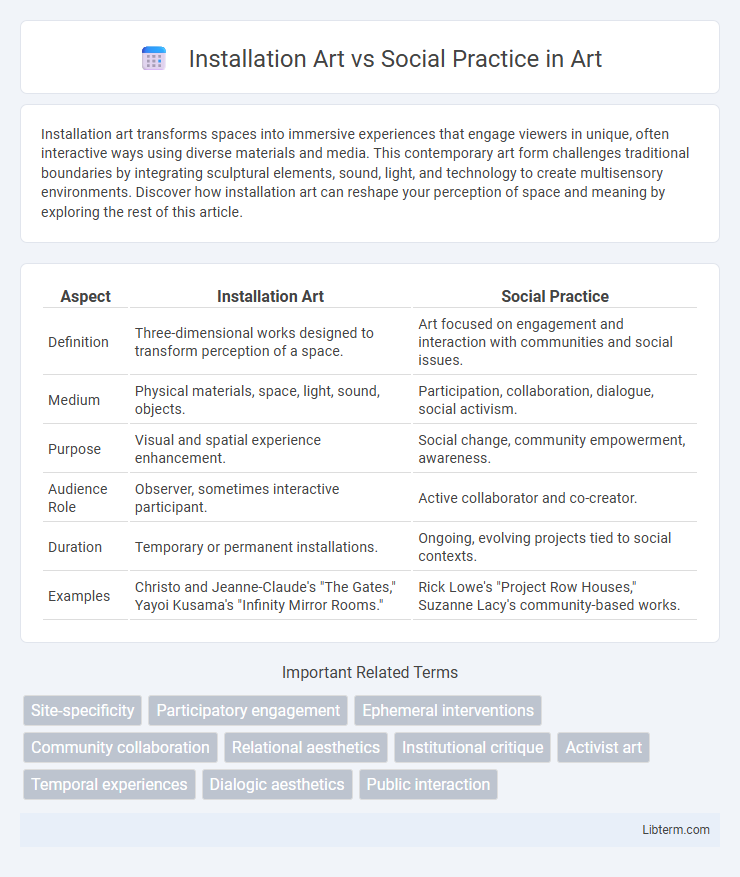Installation art transforms spaces into immersive experiences that engage viewers in unique, often interactive ways using diverse materials and media. This contemporary art form challenges traditional boundaries by integrating sculptural elements, sound, light, and technology to create multisensory environments. Discover how installation art can reshape your perception of space and meaning by exploring the rest of this article.
Table of Comparison
| Aspect | Installation Art | Social Practice |
|---|---|---|
| Definition | Three-dimensional works designed to transform perception of a space. | Art focused on engagement and interaction with communities and social issues. |
| Medium | Physical materials, space, light, sound, objects. | Participation, collaboration, dialogue, social activism. |
| Purpose | Visual and spatial experience enhancement. | Social change, community empowerment, awareness. |
| Audience Role | Observer, sometimes interactive participant. | Active collaborator and co-creator. |
| Duration | Temporary or permanent installations. | Ongoing, evolving projects tied to social contexts. |
| Examples | Christo and Jeanne-Claude's "The Gates," Yayoi Kusama's "Infinity Mirror Rooms." | Rick Lowe's "Project Row Houses," Suzanne Lacy's community-based works. |
Defining Installation Art: Concepts and Characteristics
Installation Art is an immersive, three-dimensional work designed to transform a viewer's perception of space, often incorporating diverse materials and sensory elements to engage multiple senses. It emphasizes spatial relationships, site-specificity, and interaction, challenging traditional art forms by breaking the boundaries between artwork and environment. Key characteristics include temporality, experiential engagement, and the integration of technology or found objects to evoke emotional or intellectual responses.
Understanding Social Practice in Contemporary Art
Social Practice in contemporary art emphasizes community engagement, participatory experiences, and social activism, contrasting with Installation Art's focus on creating immersive, spatial environments. Social Practice artists prioritize collaboration, dialogue, and social change, integrating art into everyday life and addressing sociopolitical issues directly. This approach challenges traditional art boundaries by transforming spectators into active participants and fostering collective meaning-making within public contexts.
Key Differences Between Installation Art and Social Practice
Installation art emphasizes immersive, site-specific environments designed to engage viewers visually or spatially, often prioritizing aesthetic experience and materiality. Social practice centers on collaborative, community-based projects that aim to address social issues and foster dialogue or change, prioritizing process and participation over physical form. The key differences lie in installation art's focus on physical, spatial expression versus social practice's commitment to interaction, activism, and community engagement.
Historical Development of Installation Art
Installation art emerged in the 1960s as artists sought to break traditional boundaries by creating immersive, three-dimensional environments that engage viewers physically and emotionally. Influenced by movements such as Dada, Surrealism, and Minimalism, installation art evolved through pioneers like Allan Kaprow, who introduced "Happenings," and later artists like Yayoi Kusama and Joseph Beuys, who expanded the medium's conceptual and material range. Its historical development reflects a shift from object-focused sculpture to experiential and site-specific works, distinguishing it fundamentally from social practice art, which centers more explicitly on community engagement and social activism.
Roots and Evolution of Social Practice Art
Social practice art emerged in the 1960s and 1970s as a reaction to the traditional spatial constraints of installation art, emphasizing community engagement and social interaction over physical form. Rooted in activism and participatory art movements, it evolved to prioritize collaborative processes and address social issues, diverging from the object-centered focus of installation art. Contemporary social practice often integrates diverse media and employs strategies that foster dialogue, reflecting a shift from isolated artistic experience to collective cultural intervention.
Audience Engagement: Passive vs Active Participation
Installation Art typically invites passive audience engagement, where viewers observe and interpret the work within a curated space, often emphasizing visual and spatial experience. In contrast, Social Practice art demands active participation, encouraging community involvement and collaborative creation that transforms audience members into co-creators. This shift from passive reception to active participation highlights the evolving role of the audience in contemporary art contexts.
Site-Specificity: Space in Installation Art and Social Practice
Installation art utilizes site-specificity by transforming physical spaces into immersive environments that engage viewers through spatial arrangement and sensory experience. Social practice art emphasizes site-specificity by fostering community interaction and addressing social contexts within a particular location, making the site's cultural and historical background integral to the artwork. Both forms rely on spatial relationships but differ as installation art centers on aesthetic and sensory manipulation, while social practice prioritizes participatory engagement and social dynamics.
Community Impact: Measuring Social Practice Outcomes
Social practice art prioritizes measurable community impact by engaging local participants in collaborative projects that address social issues, fostering empowerment and social change. Installation art, while immersive and experiential, often centers on visual and spatial engagement without direct emphasis on long-term community outcomes. Evaluating social practice art involves qualitative metrics such as participant testimonials, community cohesion indices, and social transformation indicators to gauge its effectiveness.
Notable Artists: Pioneers in Both Fields
Installation art pioneers such as Joseph Beuys, Yayoi Kusama, and James Turrell transformed spatial experiences by integrating immersive environments and sensory stimuli. Social practice leaders like Suzanne Lacy, Rick Lowe, and Theaster Gates emphasize community engagement and activism through collaborative art projects addressing social issues. Both fields intersect in artists like Tania Bruguera and Ai Weiwei, who combine immersive installations with socially-driven narratives to provoke public discourse.
Future Directions: Blurring Boundaries and New Possibilities
Future directions in installation art and social practice emphasize the blurring boundaries between immersive environments and community engagement, fostering hybrid forms that merge aesthetic experience with social impact. Emerging technologies such as augmented reality and interactive media expand possibilities for participatory art, enabling deeper collaboration and real-time feedback within diverse audiences. This convergence encourages artists to explore innovative methods that challenge traditional art spaces and societal roles, creating inclusive platforms for dialogue and transformation.
Installation Art Infographic

 libterm.com
libterm.com